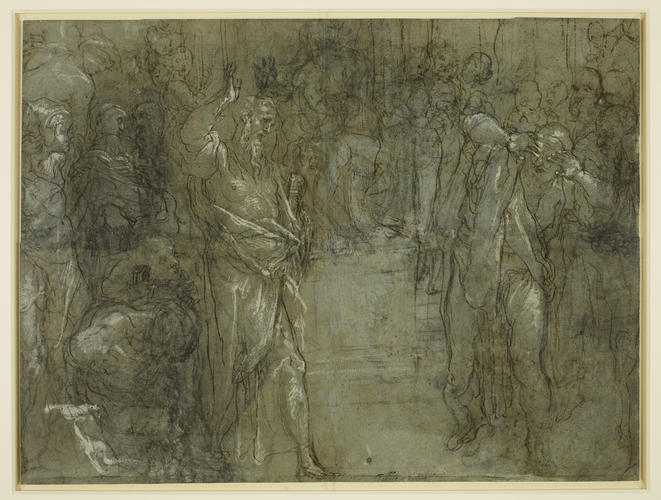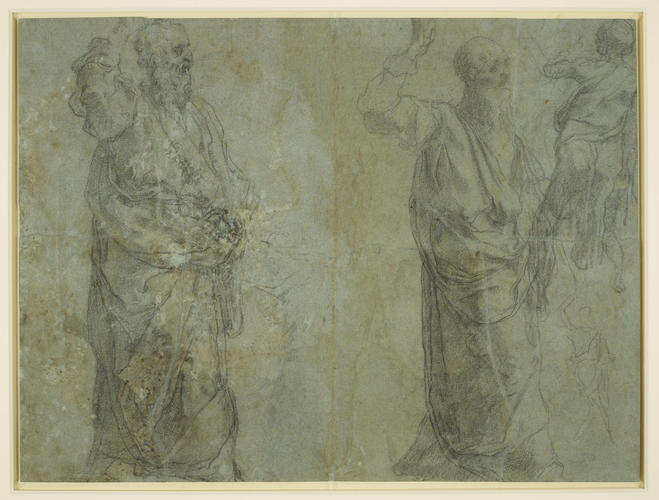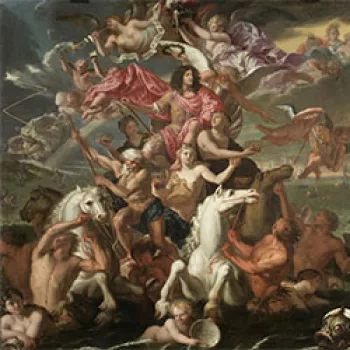The Conversion of the Proconsul c.1557-9
Pen and ink with white heightening over charcoal, on blue paper | 39.2 x 53.0 cm (sheet of paper) | RCIN 906016

Taddeo Zuccaro (1529-66)
The Conversion of the Proconsul c.1557-9

Taddeo Zuccaro (1529-66)
The Conversion of the Proconsul c.1557-9


-
Before his premature death, Taddeo Zuccaro established himself as the most dynamic painter and draughtsman in Rome. His bold sketch for a fresco in San Marcello al Corso follows Raphael's symmetrical composition of the same subject, with the proconsul seated at the centre and St Paul and Elymas either side of the foreground. The fresco itself is very different in composition.
This is a large sketch for the fresco painted by Taddeo on the left wall of the Frangipani chapel of San Marcello al Corso in Rome. According to Vasari, Mario Frangipane commissioned Taddeo to decorate the chapel with scenes from the life of St Paul following the unveiling of his work in the Mattei chapel of Santa Maria della Consolazione in 1556 (Frangipani was a member of the confraternity of that church). Throughout the project Taddeo was distracted by other work. He was not able to begin painting in the chapel for a couple of years, and though much of the barrel vault was completed in 1559-60, there was then a hiatus until 1563. The chapel was left incomplete at Taddeo's death in September 1566, and was finished by his brother Federico.
The subject is described in Acts (13:6-12). The magician Elymas tried to prevent the Roman proconsul Sergius Paulus from hearing the preaching of Paul and Barnabas; Paul struck Elymas blind, and thereby the proconsul was converted. Raphael had tackled the same subject for his commission of tapestries for the Sistine Chapel, and Taddeo here followed Raphael's symmetrical arrangement, with the proconsul seated at the centre and St Paul and Elymas either side of the foreground. As the Conversion of the Proconsul and the Healing of the Cripple opposite are the lowest of the frescoes in the chapel, they must have been begun last. It is however likely that this drawing dates from the beginning of Taddeo's work on the project, and maybe six or more years separate the drawing and the beginning of work on the painting. The composition of the painting is very different from the drawing, with the protagonists seen beyond a foreground of gesticulating semi-nude onlookers, and Popham noted that the layout here is actually closer to the fresco of the Healing of the Cripple.
Taddeo's dissatisfaction with the composition is evident from the fact that he (for it was surely he) tore up the folded sheet after its execution; some member of the workshop presumably retrieved the pieces and restored the sheet. When the drawing was lifted from its mount during recent conservation, further studies were revealed on the verso. Three of these are of St Paul in variants of the pose on the recto - two majestic studies the full height of the paper and a spidery sketch at lower right; the fourth study, at upper right, is of a startled bystander from behind, probably intended for the right foreground of the composition but not to be found in the frescoes, nor in any of the other numerous preparatory studies for the Frangipani project.
Drawings in Stockholm (by Rubens, copying a lost drawing by Taddeo or reworking such a copy) and Chicago document the evolution from the classical balance of the present design to the Mannerism of the painting. A damaged drawing in the Louvre appears to be a facsimile-type copy of the Windsor drawing; Gere thought that it might be an original study, but it is so close in detail to the present sketch that it would be hard to explain the function of such a sheet. Finally, also at Windsor is a large red chalk drawing, squared for transfer, of which Gere judged that 'in spite of its suspiciously exact correspondence with the fresco, the drawing is certainly by TZ himself; it must be the modello from which the full-size cartoon was squared'.
Inscribed lower centre in a seventeenth-century hand: Taddeo Succaro, and in an eighteenth-century hand: zuccaro
Catalogue entry adapted from The Art of Italy in the Royal Collection: Renaissance and Baroque, London, 2007Provenance
Probably Jerome Lanier (?his six-pointed star stamp, not in Lugt 1921); thus probably acquired by Charles II; possibly recorded in a list of albums of drawings at Kensington Palace, 1727; Royal Collection by c.1810 (Inventory A, p. 55. Zucharo Passarotti e Altri Maestri, among '21 to 45. Of Taddeo and Frederico Zucharo, their School, and other Masters in their Stile').
-
Creator(s)
Acquirer(s)
-
Medium and techniques
Pen and ink with white heightening over charcoal, on blue paper
Measurements
39.2 x 53.0 cm (sheet of paper)
Object type(s)
Other number(s)
RL 6016Alternative title(s)
The Blinding of Elymas









